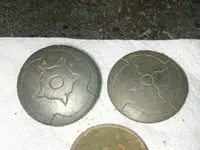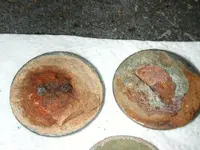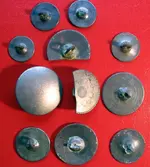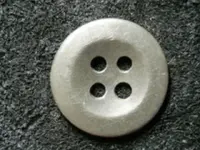I am fairly certain your buttons are not "Tombac" buttons. A Tombac is not a Pewter button. Tombac buttons did not have iron shanks, early pewter buttons did, and I would lean more towards pewter.
Here is a description of a Tombac button, which by the way, usually on the reverse you will see the spin marks.
The definitive description of Tombac used in button manufacture. Tombac, invented in the late 17th Century was used in manufacture up to but not after 1800. Tombac was a combination of Copper, Zinc and arsenic metal. It was known as "White Copper" according to David Johnson in his Uniform Button books published in the 1940's. As it goes, the Tombac metal was never white. It always turned out with a yellow sheen to it. In any case it was not used for button manufacture after 1800. One or two examples may have been found after 1800, but no signs of continued manufacture. This confirmed with Sally Luscomb's Button Collectors Book. The primary design on Tombac Buttons was made with a Lathe. The metal was brittle and would break instead of bend.
Pewter, is mostly Tin, Copper and Lead, modern day Pewter does not use lead.
The attached photo is of some of my Tombacs, you will notice the backsides are all very similiar on how the shank was attached, and on some you can see the spin marks from the lathe. Also, I includes a broken one since many of the larger Tombacs are found broken like this due to them being so brittle.
Tombacs found in America are usually considered to date 1770's to 1800.
Jules, your buttons are hard to say what age, but I do believe they predate your site and are from the 1700's.
Don





 I didn't know they existed until I found one yesterday at a site that ranges from 1780-1812.
I didn't know they existed until I found one yesterday at a site that ranges from 1780-1812.


